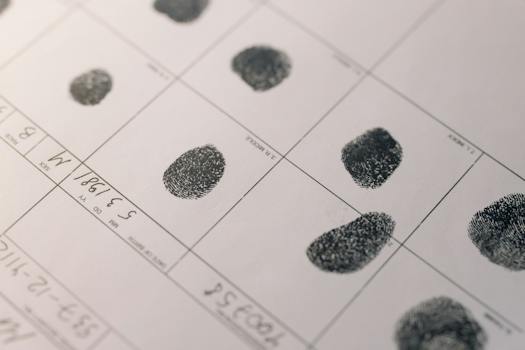

-
Table of Contents
Unveiling the Identity: Discover the Truth in Fingerprints.
Introduction
Unveiling the Identity in Fingerprints: An Introduction
Fingerprints have long been recognized as a unique and reliable means of identifying individuals. The study of fingerprints, known as dactyloscopy, has played a crucial role in forensic science and law enforcement for over a century. By examining the intricate patterns and ridges present on the fingertips, experts can unveil the identity of a person with a high degree of accuracy. This introductory article aims to explore the fascinating world of fingerprint identification, highlighting its historical significance, underlying principles, and modern techniques used to uncover the identity concealed within these distinctive patterns.
The Science Behind Fingerprints: Understanding the Unique Identity
Unveiling the Identity in Fingerprints
Fingerprints have long been recognized as a unique identifier for individuals. The science behind fingerprints is fascinating and plays a crucial role in forensic investigations. Understanding the unique identity that lies within fingerprints requires delving into the intricate details of their formation and classification.
Fingerprints are formed during fetal development, around the 10th week of pregnancy. The ridges and valleys that make up fingerprints are created by the interaction between the dermal papillae and the epidermis. As the fetus grows, these ridges and valleys become more defined, resulting in the distinct patterns we see on our fingertips.
The uniqueness of fingerprints lies in their individual characteristics. No two fingerprints are alike, not even those of identical twins. The patterns can be broadly classified into three main types: loops, whorls, and arches. Loops are the most common, accounting for about 60-65% of all fingerprints. Whorls make up approximately 30-35%, while arches are the least common, comprising only 5% of fingerprints.
Within these broad categories, there are further subdivisions based on the specific ridge patterns. These patterns include the presence of bifurcations, where a ridge splits into two, and ridge endings, where a ridge terminates. These unique characteristics are what forensic experts rely on to match fingerprints found at crime scenes to those in a database.
The process of fingerprint identification involves comparing the minutiae points, which are the specific ridge characteristics, between two prints. These minutiae points can include ridge endings, bifurcations, and even the presence of dots or islands within the ridges. By comparing these points, forensic experts can determine if two prints are from the same individual or not.
Advancements in technology have greatly aided the process of fingerprint identification. Automated fingerprint identification systems (AFIS) use algorithms to compare and match fingerprints in a fraction of the time it would take a human expert. These systems have revolutionized forensic investigations, allowing for faster and more accurate identification of suspects.
Fingerprints not only provide a unique identity but also have the ability to reveal important information about an individual's health. Certain medical conditions, such as Down syndrome and cystic fibrosis, can be detected through the presence of specific ridge patterns in fingerprints. This opens up new possibilities for early diagnosis and treatment of these conditions.
The use of fingerprints as a means of identification dates back thousands of years. Ancient civilizations, such as the Babylonians and the Chinese, recognized the distinctiveness of fingerprints and used them to seal documents and mark pottery. However, it was not until the late 19th century that fingerprints were scientifically studied and classified.
In 1892, Sir Francis Galton published his book "Fingerprints," which laid the foundation for modern fingerprint identification. Galton's work established the uniqueness and permanence of fingerprints, paving the way for their use in criminal investigations. Since then, fingerprint analysis has become an integral part of forensic science, helping to solve countless crimes and bring justice to victims.
In conclusion, the science behind fingerprints is a fascinating field that continues to evolve. The unique identity within fingerprints is formed during fetal development and remains unchanged throughout a person's life. The classification of fingerprints based on their patterns and minutiae points allows for accurate identification and has revolutionized forensic investigations. From ancient civilizations to modern technology, fingerprints have played a crucial role in identifying individuals and solving crimes. The study of fingerprints not only provides insights into an individual's identity but also holds the potential for detecting certain medical conditions. The intricate details within fingerprints truly unveil the remarkable identity that lies within each of us.
Historical Significance of Fingerprints in Criminal Investigations

Unveiling the Identity in Fingerprints
Fingerprints have long been recognized as a unique and reliable means of identifying individuals. The historical significance of fingerprints in criminal investigations cannot be overstated. From ancient civilizations to modern forensic science, fingerprints have played a crucial role in solving crimes and bringing criminals to justice.
The use of fingerprints as a means of identification dates back thousands of years. In ancient Babylon, fingerprints were used on clay tablets for business transactions. Similarly, in ancient China, fingerprints were used on official documents to prevent forgery. These early uses of fingerprints demonstrate the recognition of their individuality and uniqueness.
However, it was not until the late 19th century that fingerprints were scientifically studied and recognized as a valuable tool in criminal investigations. Sir Francis Galton, a British scientist and cousin of Charles Darwin, was one of the pioneers in this field. Galton conducted extensive research on fingerprints and developed a classification system that is still used today.
The breakthrough in the use of fingerprints in criminal investigations came in 1892 when Sir Edward Henry, an English police official, introduced the fingerprint identification system to the Scotland Yard. This system, known as the Henry Classification System, revolutionized the field of forensic science. It allowed for the systematic collection and comparison of fingerprints, making it easier to identify suspects and link them to crime scenes.
The historical significance of fingerprints in criminal investigations is evident in numerous high-profile cases. One such case is the Lindbergh kidnapping in 1932. The baby son of famous aviator Charles Lindbergh was abducted, and a ransom was demanded. The investigation focused on the ransom notes, which were found to contain fingerprints. These fingerprints ultimately led to the arrest and conviction of Bruno Hauptmann, the man responsible for the kidnapping and murder of the child.
Another notable case is that of the Unabomber, Theodore Kaczynski. Kaczynski carried out a series of bombings over a span of nearly two decades. Despite his efforts to avoid detection, it was his fingerprints that ultimately led to his capture. When authorities discovered his fingerprints on a package sent to one of his victims, they were able to link him to the crimes and bring an end to his reign of terror.
The historical significance of fingerprints in criminal investigations extends beyond individual cases. Fingerprints have also played a crucial role in the development of forensic science as a whole. The study of fingerprints has led to advancements in fingerprinting techniques, such as the use of powders and chemicals to enhance the visibility of latent prints. Additionally, the use of automated fingerprint identification systems (AFIS) has greatly expedited the identification process, allowing for faster and more accurate results.
In conclusion, the historical significance of fingerprints in criminal investigations cannot be overstated. From their early recognition as a means of identification to their scientific study and application in modern forensic science, fingerprints have proven to be an invaluable tool in solving crimes and bringing criminals to justice. The Lindbergh kidnapping and the Unabomber case are just two examples of how fingerprints have played a crucial role in high-profile cases. Furthermore, the study of fingerprints has led to advancements in forensic science as a whole. As technology continues to evolve, fingerprints will undoubtedly remain a cornerstone of criminal investigations for years to come.
Advancements in Fingerprint Technology: Enhancing Identification Accuracy
Unveiling the Identity in Fingerprints
Advancements in Fingerprint Technology: Enhancing Identification Accuracy
Fingerprints have long been recognized as a unique identifier for individuals. The distinct ridges and patterns on our fingertips have been used for centuries to solve crimes and establish personal identity. However, as technology continues to advance, so does our ability to analyze and interpret fingerprints, leading to enhanced accuracy in identification.
One of the most significant advancements in fingerprint technology is the development of automated fingerprint identification systems (AFIS). These systems use complex algorithms to compare and match fingerprints against a vast database of known prints. By digitizing and storing fingerprints electronically, AFIS has revolutionized the way law enforcement agencies process and analyze fingerprint evidence.
The use of AFIS has greatly improved the speed and accuracy of fingerprint identification. Previously, fingerprint examiners had to manually compare prints, a time-consuming and subjective process. With AFIS, the computer does the initial comparison, narrowing down potential matches for human examiners to review. This not only saves time but also reduces the chances of human error.
Another significant advancement in fingerprint technology is the ability to capture high-resolution images of fingerprints. Traditional ink and paper methods often resulted in smudged or distorted prints, making identification challenging. However, with the advent of digital fingerprint scanners, investigators can now capture clear and detailed images of fingerprints, allowing for more accurate analysis.
In addition to capturing high-resolution images, modern fingerprint scanners can also detect and record additional information, such as sweat pores and ridge thickness. These additional features provide even more unique characteristics for identification purposes. By analyzing these finer details, forensic experts can establish a more robust and reliable identification.
Furthermore, advancements in fingerprint technology have also led to the development of latent fingerprint detection techniques. Latent fingerprints are those left behind unintentionally, often as a result of sweat or oil on the skin. In the past, these prints were difficult to detect and often required the use of powders or chemicals. However, with the introduction of new techniques such as laser and alternate light sources, latent prints can now be visualized more effectively, increasing the chances of successful identification.
The integration of artificial intelligence (AI) into fingerprint technology has also played a significant role in enhancing identification accuracy. AI algorithms can analyze vast amounts of fingerprint data, identifying patterns and correlations that may not be apparent to human examiners. This technology has the potential to uncover hidden connections and solve complex cases that would otherwise remain unsolved.
Despite these advancements, it is important to note that fingerprint technology is not infallible. Factors such as poor-quality prints, damaged fingers, or deliberate attempts to alter fingerprints can still pose challenges in identification. However, with ongoing research and development, scientists and forensic experts are continuously working to overcome these limitations and improve the accuracy and reliability of fingerprint identification.
In conclusion, advancements in fingerprint technology have revolutionized the field of forensic science, enhancing the accuracy and reliability of identification. Automated fingerprint identification systems, high-resolution imaging, latent fingerprint detection techniques, and the integration of artificial intelligence have all contributed to this progress. While fingerprint technology is not without its limitations, ongoing research and development continue to push the boundaries of what is possible, ensuring that fingerprints remain a powerful tool in solving crimes and establishing personal identity.
Q&A
1. What is the process of unveiling the identity in fingerprints?
The process of unveiling the identity in fingerprints involves analyzing the unique patterns and ridges present in a person's fingerprints to determine their identity.
2. How are fingerprints used to identify individuals?
Fingerprints are used to identify individuals by comparing the patterns and ridges in their fingerprints to a database of known prints. This process is known as fingerprint matching or fingerprint recognition.
3. What are the advantages of using fingerprints for identification?
Using fingerprints for identification offers several advantages, including their uniqueness, permanence, and ease of collection. Additionally, fingerprints can provide valuable evidence in criminal investigations and are widely accepted as a reliable method of identification.
Conclusion
In conclusion, the process of unveiling the identity in fingerprints is a crucial aspect of forensic science. Fingerprints are unique to each individual, making them a reliable method for identification. Through careful analysis and comparison, forensic experts can match fingerprints found at crime scenes to known individuals, aiding in the investigation and prosecution of criminals. The use of advanced technology and databases has significantly improved the efficiency and accuracy of fingerprint identification. Overall, the study and application of fingerprint analysis play a vital role in solving crimes and ensuring justice is served.












